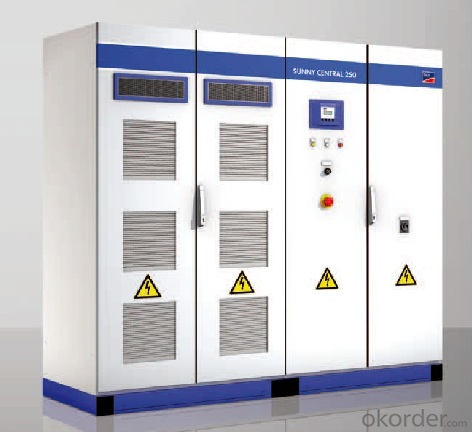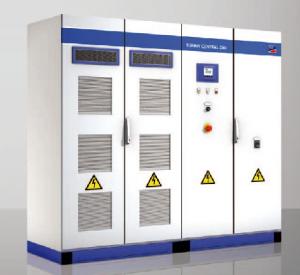PV On-Grid Inverter GSG-250KTT with High Quality
OKorder Service Pledge
OKorder Financial Service
You Might Also Like
Description:
CNBMSOLAR is a world-leading and Vertical integrated manufacturer of high-performance with Silicon,
Wafer, Cells, Modules, which convert sunlight into electricity for residential, commercial, and utility-scale
power generation.
The capacity of CNBMSOLAR is reach to 1GW, and make sure each year our shipment capacity is more
Than 700-800MWs, at the same time, we have set up the largest solar power station with our partner
in Ukraine.
CNBM is a Quality + Service oriented company with“Excellence at Each Step” approach, composed of
the finest components from TUV and IEC-certified partners around the world, CNBM modules consistently
undergo a variety of trials at the company’s Test & Development Centre, ensuring peak performance
capabilities. The company is committed to develop and provide the world with clean and renewable energy
to ease the energy shortages as well as human kind’s impact on the environment.
Data:
Isolation mode | Frequency transformer isolation | rated power | 250(KW) |
Max. DC. input power | 275(KW) | Max. input voltage | 900(VDC) |
Max. input current | 625(A) | Max. PV parralle module number | —— |
recommend PV module power | 720(VDC) | MPPT range | 440~850(VDC) |
Rated AC output power(KW) | 250(KW) | Max. output power | 275(KW) |
rated Grid voltage(VAC) | 400/480 | rated Grid frequency(Hz) | 50/60 |
Max efficiency | 97.00% | Euro efficiency | 96.00% |
Display | Touch screen | THD | <3% |
Power factor | ≥0.99 | MPPT Precision | 99% |
communication interface | RS485;RS232 | electromagnetic compatibility | IEC61000-6-1/-2/-3/-4 |
grid disruption | IEC61000-3-2/-3 | grid detection | DIN VDE 0126 |
overload operating | Automatically adjust the running peak | internal consumption at night | <80(W) |
DC voltage ripple | Vpp < 10% | protection class | IP20(outdoors) |
Anti-islanding protection | Vac;Fac | cooling concept | Forced air cooling |
operating temperature range | —20℃~55℃(>50℃drop) | operating humid range | 0~95%(non-condensing) |
Dimensions(DxWxH) | 800×1800×2140mm | weight | 2486(Kg) |
altitude | 6000m,>3000m start to drop |
|
|

FAQ:Could you pls introduce CNBM ?
CNBM Group is short for China National Building Materials Group Corporation, which is established in 1984 with approval from the State Council
CNBM Group is the largest comprehensive building materials industry group in China
The Group has a total asset of over RMB 360 billion, more than 180,000 employees and 17 subsidiaries
- Q:What certifications should I look for when choosing a solar inverter?
- When choosing a solar inverter, it is important to look for certifications such as UL listing, IEC 61727 compliance, and IEEE 1547 compliance. These certifications ensure that the inverter meets safety and performance standards, and is compatible with grid connection requirements.
- Q:What is the role of a solar inverter in preventing islanding?
- The role of a solar inverter in preventing islanding is to constantly monitor the electrical grid and disconnect the solar system from the grid when a power outage occurs. By detecting changes in grid voltage or frequency, the inverter ensures that the solar system does not continue to generate and supply power to the grid in isolation, which could potentially cause safety hazards for utility workers and damage to electrical equipment.
- Q:What is the maximum AC voltage that a solar inverter can provide?
- The maximum AC voltage that a solar inverter can provide depends on the specifications of the specific inverter model. However, for most common residential and commercial solar inverters, the maximum AC voltage typically ranges between 208 and 240 volts.
- Q:How does a solar inverter monitor and optimize energy production?
- A solar inverter monitors and optimizes energy production by converting the direct current (DC) generated by solar panels into alternating current (AC) that can be used to power electrical devices. It constantly monitors the voltage and current of the solar panels to ensure optimal performance and adjusts the conversion process accordingly. Additionally, advanced solar inverters often incorporate maximum power point tracking (MPPT) technology, which enables them to track the maximum power output of the solar panels and adjust their operating parameters accordingly, maximizing energy production. This monitoring and optimization process helps to ensure efficient and effective utilization of solar energy.
- Q:Can a solar inverter be used in harsh weather conditions?
- Yes, solar inverters can be designed and built to withstand harsh weather conditions. Many modern solar inverters are equipped with protective features such as dust and moisture resistance, temperature tolerance, and surge protection. These features make them suitable for operating in extreme temperatures, high humidity, dusty environments, and even during heavy rain or snow. However, it is important to ensure that the chosen inverter is specifically designed for the intended weather conditions to ensure its durability and performance.
- Q:How does a solar inverter handle voltage and frequency variations caused by load shedding?
- A solar inverter handles voltage and frequency variations caused by load shedding by constantly monitoring the grid conditions. When it detects a drop in voltage or frequency, it adjusts its output parameters accordingly to maintain a stable supply of electricity to the connected loads. This ensures that the devices receiving power from the solar inverter are not affected by the fluctuations in the grid caused by load shedding.
- Q:What is the role of a fault detection system in a solar inverter?
- The role of a fault detection system in a solar inverter is to monitor and identify any issues or malfunctions within the inverter system. It helps to prevent or minimize downtime by quickly detecting faults such as overvoltage, overcurrent, short circuits, or temperature abnormalities. By promptly identifying and alerting the system operator about these faults, the fault detection system allows for timely maintenance or repairs, ensuring optimal performance and safety of the solar inverter.
- Q:Can a solar inverter be used with a solar-powered data center?
- Yes, a solar inverter can be used with a solar-powered data center. A solar inverter is an essential component that converts the direct current (DC) generated by solar panels into usable alternating current (AC) electricity for powering electrical devices and systems, including data centers. By using a solar inverter, a solar-powered data center can efficiently utilize the renewable energy generated by solar panels to meet its power requirements.
- Q:What is the role of a display interface in a solar inverter?
- The role of a display interface in a solar inverter is to provide real-time information and control options to the user. It allows them to monitor the performance of the solar inverter, such as power output, energy production, and system status. The display interface also provides access to various settings and configuration options, allowing the user to optimize the performance of the solar inverter based on their specific requirements.
- Q:Can a solar inverter be used in a solar-powered street lighting system?
- Yes, a solar inverter can be used in a solar-powered street lighting system. The solar inverter is responsible for converting the direct current (DC) generated by the solar panels into alternating current (AC) that is required to power the street lights. It ensures that the energy produced by the solar panels is efficiently utilized in the lighting system.
1. Manufacturer Overview |
|
|---|---|
| Location | |
| Year Established | |
| Annual Output Value | |
| Main Markets | |
| Company Certifications | |
2. Manufacturer Certificates |
|
|---|---|
| a) Certification Name | |
| Range | |
| Reference | |
| Validity Period | |
3. Manufacturer Capability |
|
|---|---|
| a)Trade Capacity | |
| Nearest Port | |
| Export Percentage | |
| No.of Employees in Trade Department | |
| Language Spoken: | |
| b)Factory Information | |
| Factory Size: | |
| No. of Production Lines | |
| Contract Manufacturing | |
| Product Price Range | |
Send your message to us
PV On-Grid Inverter GSG-250KTT with High Quality
OKorder Service Pledge
OKorder Financial Service
Similar products
New products
Hot products
Hot Searches
Related keywords































